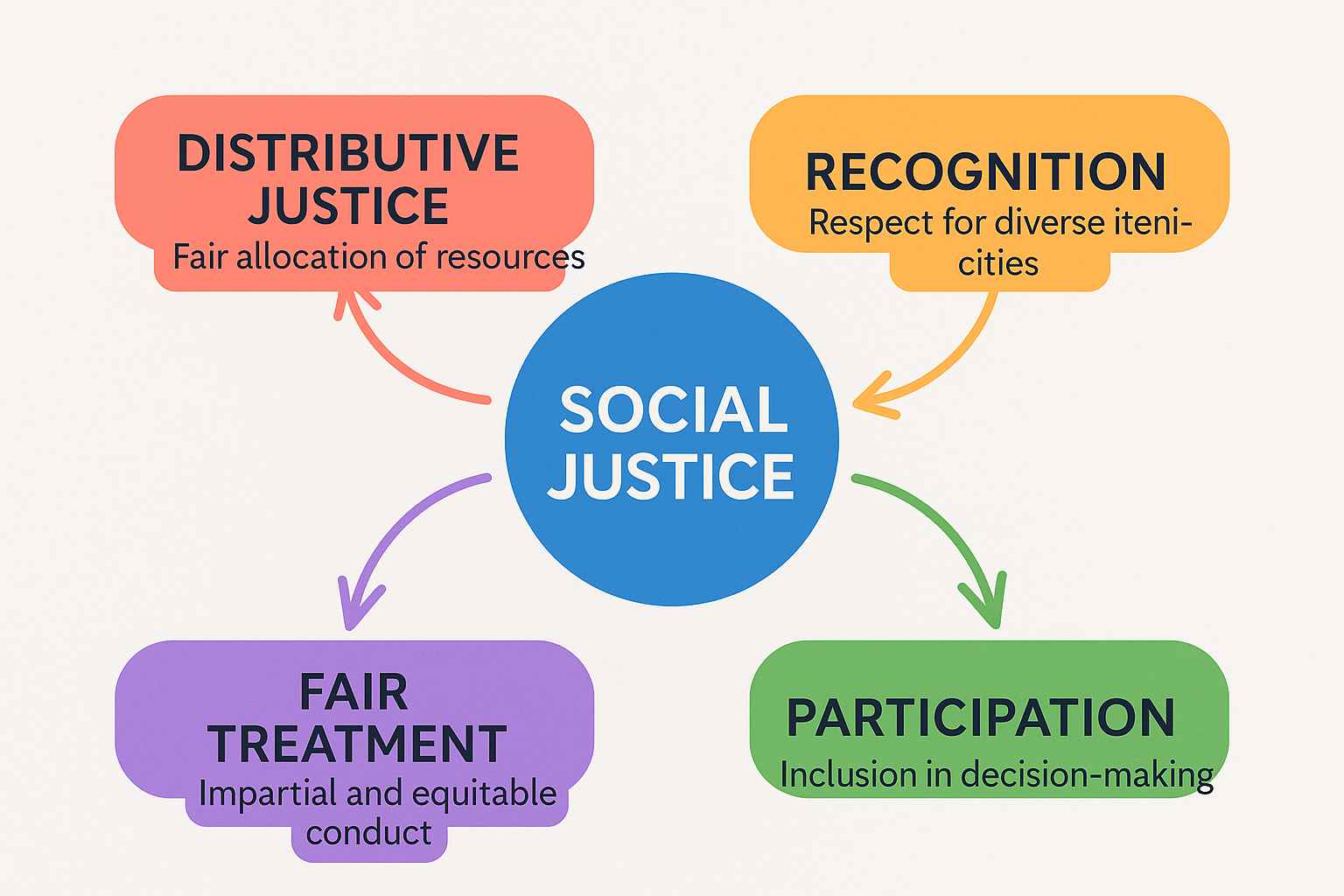Social Justice
Index
- Introduction to Social Justice
- Philosophical Foundations of Social Justice
- Principles and Dimensions of Social Justice
- Theories of Social Justice
- Social Justice and Human Rights
- Social Justice and Economic Inequality
- Social Justice and Caste in India
- Gender Justice as Social Justice
- Social Justice and Indigenous Rights
- Environmental Justice and Sustainability
- Social Movements and Social Justice
- Challenges to Social Justice in the Contemporary World
- Role of the State, Law, and Civil Society in Promoting Social Justice
- Conclusion

Introduction to Social Justice
Social justice is one of the most foundational yet contested concepts in social theory, public policy, and moral philosophy. It refers to the fair and equitable distribution of resources, opportunities, privileges, and responsibilities within a society. The idea of social justice rests on the belief that every individual deserves equal access to wealth, health, well-being, justice, and opportunity regardless of their background. While the term gained prominence during the 19th century amid growing concerns over inequality and exploitation in industrial societies, its philosophical roots extend to ancient thinkers like Plato and Aristotle. In modern times, social justice has become a central value underpinning democratic constitutions, international law, and human rights frameworks. It seeks to dismantle structural inequalities and empower marginalized communities. The pursuit of social justice is not limited to charitable or welfare-oriented acts but involves a structural transformation of institutions, ideologies, and power relations to build a more just, inclusive, and sustainable society.
Philosophical Foundations of Social Justice
The philosophical underpinnings of social justice are derived from diverse traditions, including liberalism, Marxism, utilitarianism, and communitarianism. From a liberal perspective, justice entails protecting individual rights and ensuring equal opportunities for all, as emphasized by thinkers like John Locke and Immanuel Kant. Kantian ethics, in particular, advocated for treating individuals as ends in themselves, forming a moral basis for social equality. In contrast, Marxist thought emphasized economic justice and the dismantling of class hierarchies, arguing that true justice cannot be achieved without eliminating capitalism and private property. Utilitarian philosophers like Jeremy Bentham and John Stuart Mill proposed maximizing overall happiness, yet their approach has been criticized for potentially ignoring minority rights. Communitarian thinkers such as Alasdair MacIntyre stressed the importance of community values and cultural contexts in defining justice. These philosophical traditions converge on the necessity of fairness, but diverge on how it should be realized and who should bear responsibility for it.
Principles and Dimensions of Social Justice
Social justice is not a monolithic idea; it encompasses multiple overlapping dimensions that address distinct but interconnected aspects of human life and society.
Distributive Justice
Distributive justice focuses on the fair allocation of resources, wealth, income, and opportunities in a society. It raises fundamental questions about who gets what, why, and how. Theories of distributive justice often grapple with competing notions of equity (allocating resources according to need or contribution), equality (everyone gets the same), and sufficiency (everyone gets enough). This dimension of justice underlies debates around taxation, welfare, affirmative action, and access to education and healthcare.
Procedural Justice
Procedural justice emphasizes fairness in decision-making processes. It is not just the outcomes but the transparency, consistency, and impartiality of procedures that determine whether justice is achieved. For instance, in the legal system, ensuring a fair trial, due process, and unbiased judgments are essential components of procedural justice. In governance, democratic participation, inclusive policy-making, and responsiveness are procedural concerns.
Restorative Justice
Restorative justice seeks to repair the harm caused by injustice or wrongdoing, often through reconciliation between victims and offenders. This approach shifts focus from punishment to healing, accountability, and transformation. It is particularly significant in post-conflict societies, criminal justice reform, and indigenous traditions of justice where community restoration takes precedence over retribution.
Recognition and Cultural Justice
Recognition justice deals with the respect and acknowledgment of diverse identities, cultures, and ways of life. It involves overcoming misrecognition, cultural domination, and systemic invisibility that marginalized communities experience. As argued by Axel Honneth and Nancy Fraser, justice also requires recognizing the dignity of all individuals and ensuring symbolic as well as material parity in society.
Theories of Social Justice
John Rawls’ Theory of Justice
John Rawls, in A Theory of Justice (1971), provided one of the most influential liberal accounts of social justice. He proposed two principles: (1) the liberty principle—equal basic liberties for all; and (2) the difference principle—social and economic inequalities are to be arranged to benefit the least advantaged and must be attached to positions open to all. His “original position” and “veil of ignorance” thought experiment sought to ensure impartiality in deciding the principles of justice. Rawls’ theory emphasizes fairness over utility and strongly influences debates on equality and public policy
Amartya Sen’s Capability Approach
Sen critiqued Rawls’ theory for focusing too much on distribution of goods rather than actual capabilities or freedoms people have. According to Sen, justice should be assessed based on people’s real abilities to lead lives they value. This approach considers health, education, political freedom, and social participation as core capabilities. Sen’s framework is especially powerful in contexts of development, poverty, and inequality, as it shifts attention to what people are able to be and do.
Martha Nussbaum’s Capabilities Theory
Building on Sen’s work, Nussbaum formulated a list of ten central capabilities—such as bodily health, emotions, affiliation, and control over one’s environment—which every society must guarantee its citizens to achieve justice. Her approach adds a normative dimension and stresses that human dignity requires ensuring these capabilities for all, especially the most vulnerable groups, including women, children, and the disabled.
Nancy Fraser’s Perspective on Justice
Nancy Fraser introduced a multidimensional framework of justice that combines redistribution (economic), recognition (cultural), and representation (political). According to Fraser, focusing solely on one dimension overlooks structural injustices embedded in institutions. Her theory bridges class, gender, race, and disability, arguing that social justice must be transformative, not merely affirmative. She champions participatory parity—the idea that all individuals should be able to participate as equals in social life.
Social Justice and Human Rights
Social justice and human rights are deeply interlinked. Human rights provide a legal and moral framework to demand social justice across dimensions like health, education, labor, and housing. Instruments like the Universal Declaration of Human Rights (1948) and International Covenant on Economic, Social and Cultural Rights (1966) recognize that justice cannot be achieved without securing basic rights for all. However, the realization of these rights often faces political resistance, institutional inertia, and resource constraints. In many countries, human rights are unevenly applied, with marginalized communities—such as Dalits, refugees, or LGBTQ+ persons—facing systemic denial. Social justice demands not only legal recognition but also proactive policies to ensure that rights are accessible, meaningful, and enforceable.
Social Justice and Economic Inequality
Economic inequality is one of the most glaring violations of social justice in contemporary times. The concentration of wealth among a small elite, as documented by Thomas Piketty and Oxfam reports, leads to unequal access to education, health, housing, and political voice. Social justice critiques the structural conditions—such as tax policies, labor laws, privatization, and globalization—that perpetuate inequality. Redistribution through progressive taxation, social safety nets, and universal basic services is often advocated as a means of achieving justice. However, economic justice also requires changing the relations of production and consumption, empowering workers, and democratizing ownership. In India, issues like jobless growth, informal labor, and agrarian distress are central to the debate on economic justice.
Social Justice and Caste in India
In the Indian context, social justice cannot be discussed without addressing caste. The caste system has historically entrenched inequality through practices of exclusion, untouchability, and occupational segregation. The Indian Constitution, under the leadership of Dr. B.R. Ambedkar, enshrined provisions for affirmative action, reservation, and abolition of untouchability. However, caste-based discrimination persists in access to education, employment, justice, and dignity. Dalit and Adivasi communities face structural violence and social ostracism. Social justice movements such as the Dalit Panthers, Bahujan Samaj Party, and Ambedkarite organizations have played a crucial role in asserting caste justice. Social justice in India must therefore address both redistributive and recognition-based injustices rooted in caste hierarchies.
Gender Justice as Social Justice
Gender justice is a critical component of social justice that challenges the patriarchal structures embedded in social institutions like family, economy, religion, and politics. Gender-based violence, wage gaps, reproductive rights, unpaid care work, and under representation in leadership are systemic issues that require structural redress. Feminist theorists have shown how both capitalist and cultural practices reinforce gendered hierarchies. Intersectional feminism highlights how gender oppression is compounded by caste, class, race, and sexuality. Gender justice demands legal reforms (e.g., laws on domestic violence or maternity benefits), economic empowerment (e.g., equal pay, property rights), and cultural transformation (e.g., challenging gender stereotypes). True gender justice ensures the dignity, agency, and autonomy of all individuals, regardless of their gender identity.
Social Justice and Indigenous Rights
Indigenous peoples across the world have historically been dispossessed of their land, culture, and sovereignty. Social justice in this context involves land restitution, cultural preservation, political autonomy, and environmental protection. The UN Declaration on the Rights of Indigenous Peoples (2007) recognizes their right to self-determination. In India, Adivasis face displacement due to mining, dams, and deforestation. Despite constitutional safeguards like the Fifth Schedule and PESA Act, implementation remains weak. Social justice requires recognizing indigenous knowledge systems, ensuring informed consent, and respecting their spiritual relationship with nature. Movements like Narmada Bachao Andolan and Jharkhand Mukti Morcha reflect struggles for tribal justice.
Environmental Justice and Sustainability
Environmental justice is an emerging domain of social justice that links ecological sustainability with human rights. Poor and marginalized communities disproportionately bear the brunt of environmental degradation, climate change, and resource scarcity. From industrial pollution in Bhopal to rising sea levels affecting coastal populations, environmental injustice deepens existing social inequalities. Eco-social justice demands a transition to sustainable practices, equitable distribution of environmental goods, and participation of affected communities in decision-making. Concepts like climate justice, food justice, and energy democracy seek to reframe environmental issues through a social justice lens. Indigenous and ecofeminist voices are increasingly central in advocating for a just and livable future.
Challenges to Social Justice in the Contemporary World
Despite growing awareness, achieving social justice faces numerous challenges. Neoliberal globalization has led to privatization of public services, weakening of labor protections, and commodification of essential goods. Authoritarian regimes suppress dissent and roll back civil liberties. Populist and majoritarian politics exacerbate exclusion and discrimination. Digital inequality further marginalizes already disadvantaged groups. Moreover, justice fatigue, tokenism, and performative allyship dilute genuine efforts. Climate change, pandemics, and war add new layers of complexity. In such a context, social justice requires reimagining democratic institutions, renewing civic engagement, and fostering cross-movement solidarity.
Role of the State, Law, and Civil Society in Promoting Social Justice
The state plays a pivotal role in institutionalizing social justice through laws, policies, and welfare mechanisms. Constitutional provisions, judicial interventions, and affirmative action programs are vital tools. However, state action alone is insufficient. Civil society—comprising NGOs, media, academia, and community organizations—acts as a watchdog, innovator, and mobilizer. Legal activism, strategic litigation, and people’s tribunals hold powerful institutions accountable. Education, public discourse, and ethical leadership are equally important in fostering a culture of justice. Social justice is thus a collective endeavor that transcends sectors and scales.
Conclusion
Social justice is both an ideal and a process. It demands a radical rethinking of societal norms, economic structures, and political institutions to ensure fairness, dignity, and equity for all. While its meanings may vary across contexts, its core commitment remains constant: to challenge oppression, promote inclusion, and uphold human dignity. As inequalities deepen in an interconnected world, the pursuit of social justice is more urgent than ever. It is a moral imperative, a political goal, and a transformative practice that must be carried forward by individuals, communities, and institutions alike.
References
- Rawls, J. (1971). A Theory of Justice. Harvard University Press.
- Sen, A. (1999). Development as Freedom. Oxford University Press
- Fraser, N. (2008). Scales of Justice: Reimagining Political Space in a Globalizing World. Columbia University Press.
- Nussbaum, M. (2011). Creating Capabilities: The Human Development Approach. Harvard University Press.
In the beginning of recorded ethical and legal thought the term justice was used as equivalent to righteousness in general. Justice comprised the whole of virtue and complete conformity with the approved pattern of moral conduct. For purposes of rational analysis, the classic philosophers following Aristotle preferred to restrict to term reference to a particular virtue distinguishing between justice and equity or between justice and charity. In common sense justice still retains significant traces of its original comprehensiveness.
|
|
According to Plato justice regulates and equilibrates the other virtues. Whether writ small within the individual psyche or writ large in the workings of the political state its functions are to achieve harmony and to maintain equilibrium. To do these things reason must rule within the psyche and reason's embodiment must rule within the state. Justice results from each element in society doing the appropriate task, doing it well and doing it only. Influenced by Plato subsequent philosophers have concentrated on the tension between justice as an impartial application of established substantive rules and justice as an ideal criterion or reformer of such rules.
- Types of Justice
- Judicial Review in India
- Constitutional Provisions for Judicial Review in India
- Judicial Activism in India
- Justice

 |
© 2025 sociologyguide |
 |














Social Movements and Social Justice
Social movements have historically been the driving force behind social justice. From the Civil Rights Movement in the US to the anti-apartheid struggle in South Africa, movements have mobilized collective action against systemic oppression. In India, movements for land rights, feminist justice, labor rights, queer rights, disability rights, and anti-caste struggles have redefined the contours of justice. These movements combine moral critique, grassroots activism, and policy advocacy to confront power. Social justice movements often challenge not only material inequality but also symbolic misrecognition and epistemic exclusion. The rise of digital platforms has also enabled transnational justice movements like #BlackLivesMatter and Fridays for Future to gain global traction.